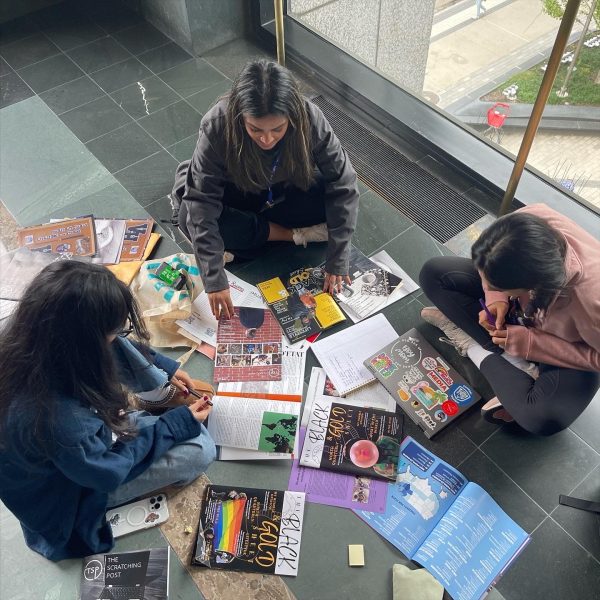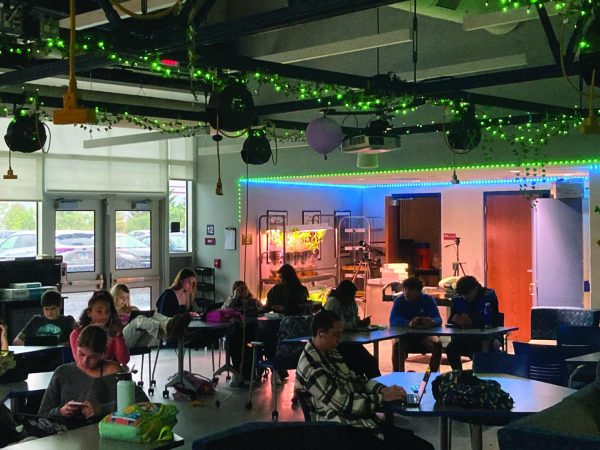How to show a little more love to our planet
A drawing of a foot print stamped on a drawing of the Earth, representing a carbon footprint.
Plastic water bottles? No, thanks. Food in the recycling bin? Plain disrespectful. Fast fashion? Don’t do it for the kids!
As the global climate crisis becomes more apparent, the choices we make in our everyday lives can have harsher effects on the environment.t. Living an eco-friendly lifestyle can seem daunting, but there are many simple ways to alter daily habits to show a little extra love to our planet.
Awareness
Awareness of climate change is important, but being conscientious of how your choices impact the environment is the first step towards realizing a more eco-friendly lifestyle.
Eliana Bernat (11) suggests using a carbon footprint calculator to find out which areas of your life are the most unfriendly to the planet. One site I find useful is the Ecological Footprint Calculator by the Global Footprint Network.
It’s important to focus on your biggest impact because going vegan when you’re already vegetarian isn’t going to do as much as using reusable bags when you typically use plastic ones.
Jacquelyn Han (11) first became aware of her impact through a documentary called “An Inconvenient Truth” starring 45th Vice President, Al Gore.
“Realizing how this ginormous change is going around in our climate and how our daily lives have an affect on that, having that awareness really changed my idea about the way I was living my life,” Han said.
Han encourages appealing to others’ interests in order to effectively communicate. For her father, it was watching a documentary about the effects of the meat industry.
“For a while, I thought my dad would never be on board with being vegetarian because he likes meat, but then, he watched a documentary about the benefits of vegetarianism and now, he’s been cooking a lot more vegetarian things for us,” Han said.
Food
Many of us don’t realize where our food is sourced from and that the components of production can be detrimental to the environment. From the water it takes to hydrate cows to the gasoline needed for the trucks to transport the meat— the steps taken to deliver this staple to your house are costly.
According to the U.S. Environmental Protection Agency (EPA), livestock production contributes to 4.2% of greenhouse gas emissions. We also need to take into account the fuel and other effects of transporting produce.
Of course, completely cutting meat out of the diet is sensibly unattainable for some, but hopefully, you will say yes to baby steps (and baby carrots).
Bernat doesn’t consume meat partly because of the environmental benefits, so she suggests others try vegetarianism or veganism. Veganism is different from vegetarianism in that it excludes all animal products.
She also understands that meat and dairy are integral parts of many’s diets, so if a plant-based diet is not for you, try Meatless Mondays instead. It’s a low commitment change that allows for some culinary exploration as well!
Remember that out-of-season fruits and veggies also have a large impact on the environment as well. Transportation of produce contributes heavily to greenhouse gas emissions, so when possible, do your best to shop in season.
No to Plastic
As Jimmy Fallon once said, “Ew!” I’d have to agree with him on this one.
In a world of constant innovation, it’s neither expensive nor hard to find plastic alternatives.
Devin Mulcrone (11) tries to reduce his plastic consumption by substituting plastic water bottles for a reusable one. At school and even at home, Mulcrone would use a metal water bottle.
The good thing is that single-use plastics are beginning to be “un-normalized” and replaced with items like metal straws, fabric grocery bags, bamboo toothbrushes, etc.
Saira Alavi (11) and her family have made a few small adjustments to their home products like switching to laundry detergent sheets and shampoo bars in order to reduce plastic waste.
Other small changes can include cloth napkins rather than paper ones, silicone food covers instead of plastic wrap, or reusable ziploc bags.
Shopping
Another overlooked factor is often clothing. Fast fashion brands such as H&M, Zara, etc. have had many issues in the past with pollution and unethical labor policies.
Thousands of tons of textile wastes are dumped into landfills annually. According to the Environmental Protection Agency (EPA) in 2018 alone, 9,070 tons were landfilled. So, how do we keep clothing out of the landfills?
Fortunately, thrifting has been a trendy alternative in recent years. Buying second hand clothes helps to reduce the amount of non-recyclable textiles going into the trash. Maybe you’ll find yourself a pair of vintage jeans while you’re at it.
Shopping locally is a great alternative as well. Local businesses often don’t partake in the pollutive industry that is mass production. With everything being produced on a smaller scale, there is less waste and you get a little extra love in every product.
The most important thing, however, is reducing consumption as a whole. While the latest sales on Amazon may seem enticing, the most effective way to decrease your footprint is to simply not buy what you don’t need.
Waste
Maybe we can’t magically make the clothes in the landfill disappear, but we can definitely take steps in our own homes to decrease the amount of waste going into the landfills.
For starters, Mulcrone recommends recycling. Plastic bottles, soda cans, paper and other materials often get mistakenly thrown in the trash when they can be recycled. They can be repurposed into other materials or objects, and most importantly, be kept out of landfills.
Han also suggests buying products that have less packaging on them to reduce plastic waste and other non-biodegradable materials going into the garbage. This can include bar soaps, paper-wrapped goods, items with biodegradable packaging, etc.
Bernat and Alavi have taken on a more radical approach to reducing food waste by composting.
“My family has gotten really into composting, and we have dramatically reduced our waste. Our garbage bin has been a lot less full, which is good,” Alavi said.
The EPA estimated that in 2018, food consisted of the largest portion of our everyday trash in the landfills, amounting to 24%.
If you don’t garden, live in an apartment, worry about the stench or all of the above, there are plenty of community gardens that will accept your compost. Just collect your food scraps and dump them into the compost bins for neighboring families to utilize.
Government Action
Up until this point, we’ve discussed small-scale, individual actions. As important as it is for each of us to contribute our own efforts to reduce our footprint, government action needs to happen in order for massive change to occur.
This doesn’t mean it’s pointless to pick up litter when you see it on the sidewalk, but small actions won’t amount to the grandness of the climate crisis.
If Meatless Mondays and local bars of soaps are still too much, you can always start by signing petitions, spreading awareness and pressuring officials to create policies and regulations that protect our planet.
Our effects on the environment aren’t nearly as detrimental as large corporations, which can only be regulated by the government.
I can name one industry off the top of my head — the oil industry. We’ve seen major oil companies capitalize off the exploitation of land and wildlife, especially with fracking.
If this doesn’t sound any alarms for you, maybe think about how your next camping trip destination will instead be a giant, gaping hole of destruction. Just a thought!
If big, bad oil companies can spend millions of dollars lobbying and influencing policymakers, we can come together to make a change, too.
“Really, for climate change, in order for it to be stopped in its tracks, it needs to be taken on a governmental and international level,” Han said.











